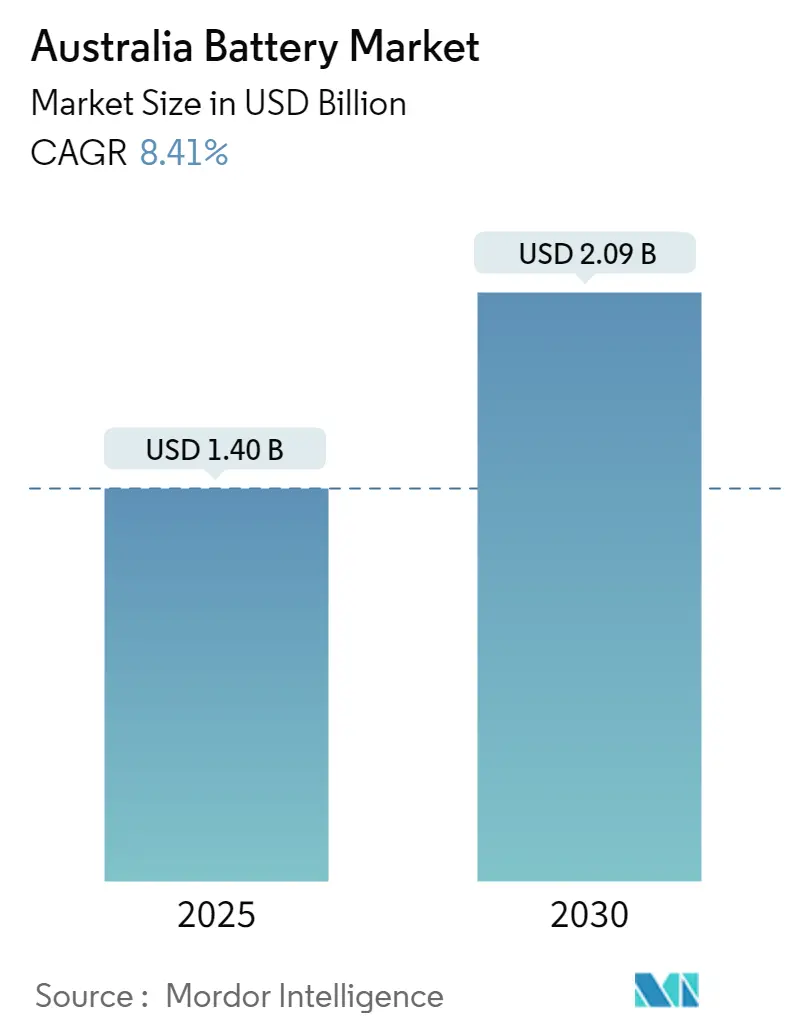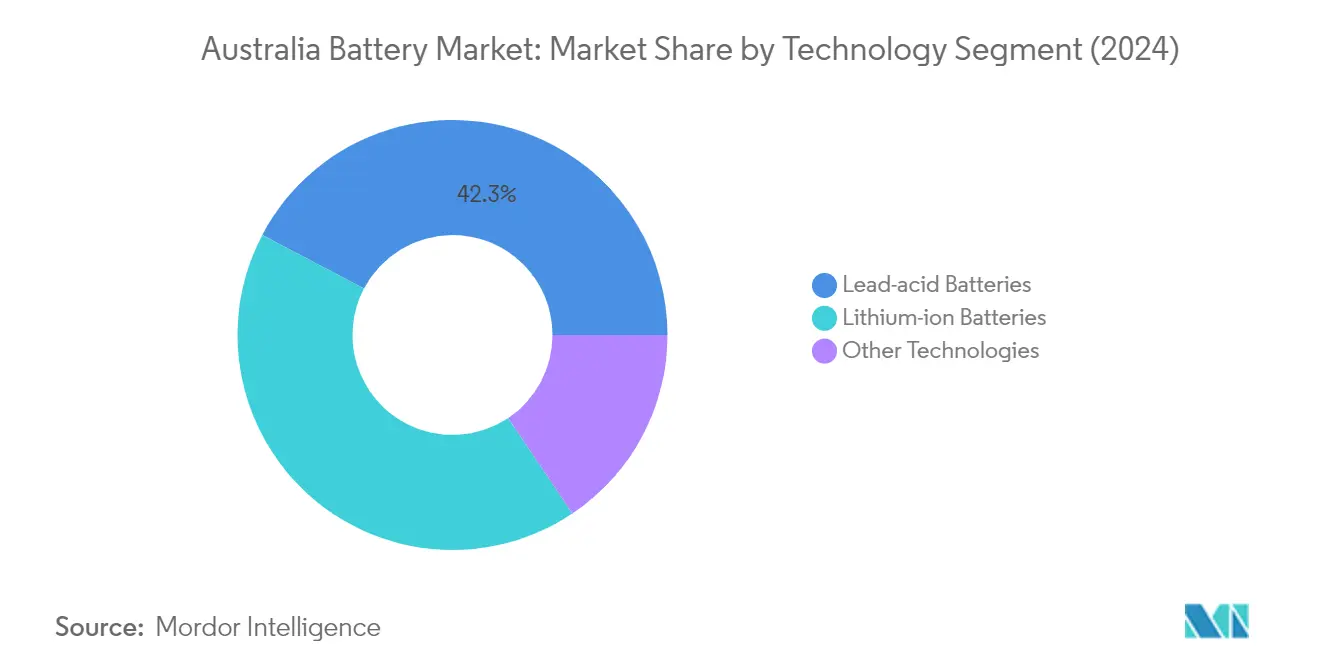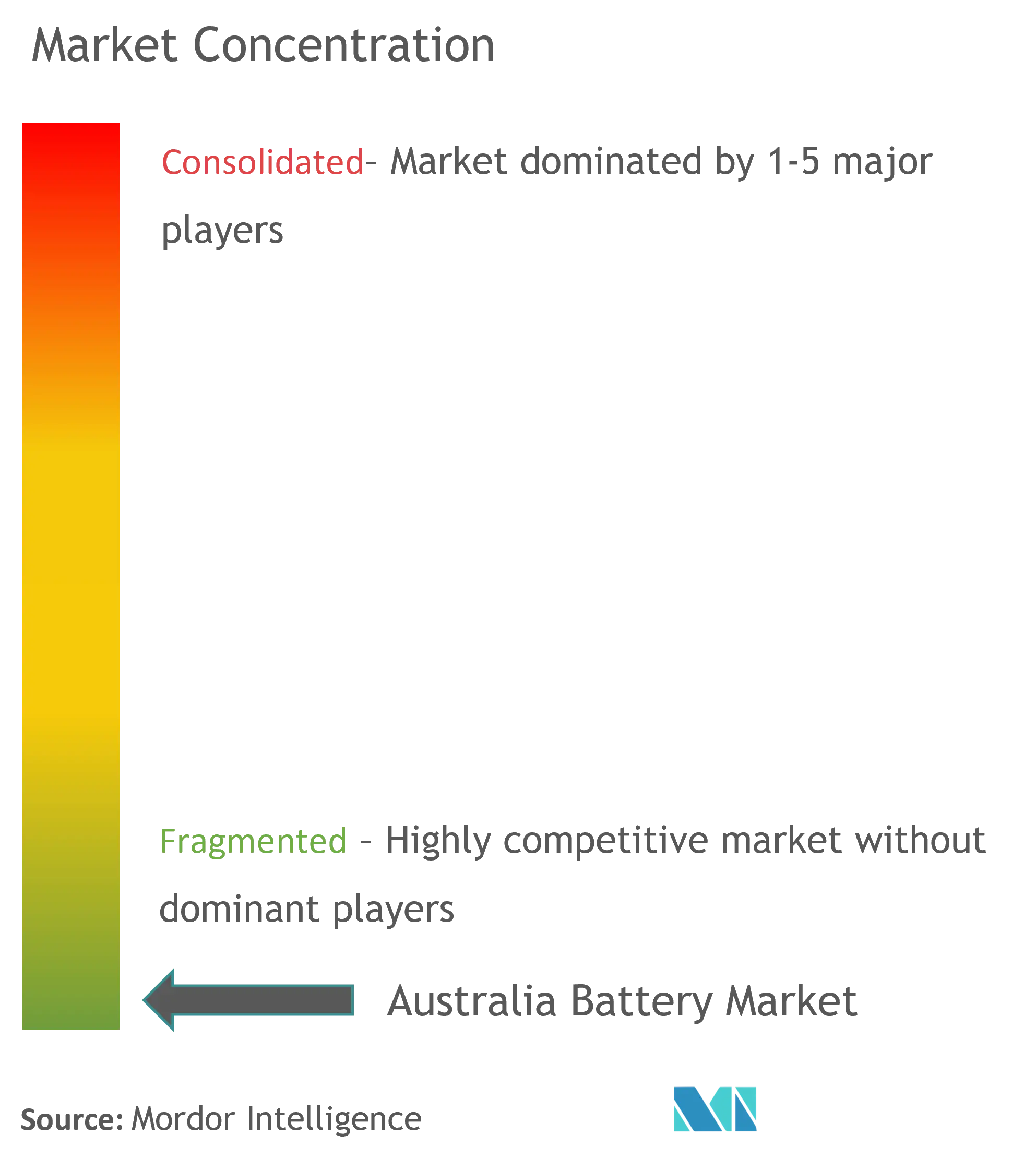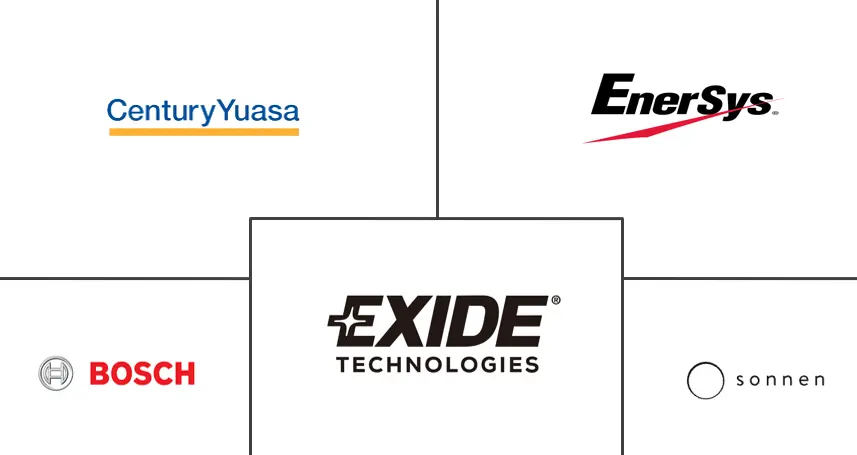
Australia Battery Market Analysis by Mordor Intelligence
The Australia Battery Market size is estimated at USD 1.40 billion in 2025, and is expected to reach USD 2.09 billion by 2030, at a CAGR of 8.41% during the forecast period (2025-2030).
Australia's battery industry is experiencing significant transformation, driven by its strategic position as the world's largest producer of hard-rock lithium spodumene. The country's abundant lithium resources and technical expertise have enabled producers to scale up operations quickly and competitively. This advantage is particularly significant as the global battery supply chain continues to evolve. The Australian government's commitment to developing the battery industry is evident through various initiatives, including substantial investments in research and development of alternative battery technologies.
The market is witnessing notable technological advancements and innovations, particularly in energy storage battery solutions. In 2023, research institutions like the University of Wollongong made significant progress in developing sodium-ion batteries as alternatives to traditional lithium-ion batteries, with plans for commercial testing at the Bondi pumping station. These developments are particularly important as they align with the country's focus on sustainable and cost-effective energy storage battery solutions. The research community's efforts are complemented by industry players like VARTA AG, which introduced an advanced version of their energy storage product, Varta Pulse Neo, featuring sophisticated operating systems and smart home compatibility.
The industrial and commercial sectors are demonstrating increased adoption of industrial battery technologies, particularly in telecommunications and infrastructure development. The Australian government's commitment to infrastructure development is reflected in its AUD 110 billion investment over ten years starting from 2021-2022 through its rolling infrastructure pipeline. This substantial investment is expected to drive demand for various industrial battery applications across construction and industrial sectors. Additionally, the healthcare sector's growing technological requirements, supported by the government's AUD 79 million investment in digital health technologies, are creating new opportunities for commercial battery applications in medical devices and equipment.
The market is also experiencing a shift in consumer behavior and technological preferences, particularly in portable battery electronics and automotive applications. The increasing digitalization of various sectors is evident from the significant rise in internet data usage, which reached 8.2 terabytes in Q2 2020 from 2.2 terabytes in Q2 2016, indicating a growing demand for portable battery-powered devices. This trend is complemented by the automotive sector's evolution, with the market showing strong growth signals. The integration of advanced battery technologies in various applications, from consumer electronics to industrial equipment, continues to drive innovation and market expansion.
Australia Battery Market Trends and Insights
Abundant Natural Resources and Strategic Mining Developments
Australia's natural endowment with critical battery minerals, including lithium, nickel, and cobalt, positions it as a crucial player in the global battery supply chain. The country's established mining infrastructure and recent strategic developments are significantly driving the battery market forward. In April 2023, the Western Australian government demonstrated its commitment to resource development by awarding Exploration Incentive Scheme (EIS) co-funded drilling grants worth USD 220,000 each for the Mangaroon Rare Earth Elements and Tarraji-Yampi Projects, strengthening the upstream battery material supply chain.
The increasing international partnerships and investments in Australian mining operations are further accelerating market growth. In May 2023, Indian mining giant NMDC initiated discussions with Australian miners and the government for lithium mining partnerships, while Core Lithium received crucial approvals for early works at the BP33 underground mine with approved funding of USD 40-50 million for the Finniss lithium project. These developments, coupled with Australia's position as the world's largest lithium producer and holder of the second-largest cobalt reserves globally, are creating a robust foundation for domestic electric vehicle battery manufacturing and market expansion.
Growing Automotive Industry and Electric Vehicle Adoption
The Australian automotive sector's robust growth and increasing electric vehicle adoption are creating substantial demand for various automotive battery technologies. According to the Federal Chamber of Automotive Industries (FCAI), vehicle deliveries reached 1,081,429 units in 2022, representing a 3% increase from the previous year, driven by the entry of new automotive brands and models. The fourth quarter of 2022 witnessed significant product launches from major manufacturers like Toyota and Nissan, including updates to Australia's popular vehicles such as the Toyota HiLux, RAV4, Corolla, and Camry, alongside the introduction of new Nissan models.
The market is experiencing a transformation with the rising adoption of electric vehicles, which demonstrated notable growth of 3.8% in 2022 compared to the previous year. This shift is driving demand for both traditional lead-acid automotive batteries for conventional vehicles and advanced lithium-ion electric vehicle batteries for electric vehicles. The automotive sector's requirements span across Starting, Lighting, and Ignition (SLI) automotive batteries, which are crucial for vehicle operations, providing short power bursts for engine starting and managing electrical loads. The industry's continued reliance on lead-acid automotive batteries for SLI applications in conventional vehicles, combined with the growing electric vehicle segment, is creating a diverse and expanding market for automotive batteries.
Segment Analysis: By Technology
Lead-Acid Battery Segment in Australia Battery Market
The lead-acid battery segment holds a dominant position in the Australian battery market, accounting for approximately 42% of the total market share in 2024. Lead-acid batteries continue to maintain their stronghold in the market due to their low cost, high performance, and well-established recycling infrastructure, with nearly 100% recyclability of materials. These batteries are particularly dominant in Starting Lighting Ignition (SLI) applications for conventional vehicles, where they remain the most economically viable mass-market technology. Australia has two major manufacturers of lead-acid batteries, Century Yuasa Batteries and Pacific Marine, which serve the domestic demand alongside imports. The technology's reliability, simple charging process, and ability to supply large surge currents make it particularly suitable for automotive applications, backup supplies for mobile phone towers, hospitals, and off-grid remote storage applications.

Lithium-Ion Battery Segment in Australia Battery Market
The lithium-ion battery segment is experiencing the most rapid growth in the Australian battery market through 2024-2029, driven by increasing adoption in electric vehicles, energy storage systems, and consumer electronics. Australia's position as the world's largest producer of hard-rock lithium spodumene provides a significant advantage in the lithium-ion battery value chain. The segment's growth is further accelerated by declining battery costs, improved technology, and supporting government initiatives. The high energy density, longer cycle life, fire resistance, and rapid charging capabilities of lithium-ion batteries make them increasingly preferred over traditional battery technologies. The country's private investments in battery manufacturing and the government's focus on developing the domestic battery industry are creating new opportunities for market expansion.
Remaining Segments in Battery Technology Market
Other battery technologies in the Australian market include nickel-cadmium batteries (NiCd), nickel-metal hydride (NiMH) batteries, and dual carbon batteries. These technologies continue to serve specific niche applications where their unique characteristics provide advantages over lithium-ion and lead-acid batteries. For instance, NiMH batteries offer higher energy density compared to NiCd batteries and are more environmentally friendly. The recycling of these batteries provides the market with economically and technologically important metals, including nickel, cobalt, and rare earth elements. However, the availability of more advanced alternatives at competitive prices has impacted the growth potential of these segments.
Segment Analysis: By Application
SLI Batteries Segment in Australia Battery Market
Starting, Lighting, and Ignition (SLI) batteries represent the largest segment in the Australian battery market, commanding approximately 43% market share in 2024. This dominance is primarily attributed to the widespread use of these batteries in conventional vehicles for powering starter motors, lights, ignition systems, and other internal combustion engines requiring high performance and long life. The segment's strength is reinforced by the continued demand from the automotive aftermarket sector and the fact that even with the transition towards electric vehicles, conventional vehicles continue to use SLI-type lead-acid batteries for various electronics and safety features. Advanced lead-based batteries, particularly absorbent glass mat (AGM) and enhanced flooded batteries, are increasingly being adopted in start-stop systems, which can reduce fuel consumption by up to 5-10% in micro-hybrid vehicles, further solidifying the segment's market position.
Automotive Batteries Segment in Australia Battery Market
The automotive batteries segment, specifically for hybrid and electric vehicles (HEV, PHEV, EV), is experiencing the fastest growth in the Australian battery market for the period 2024-2029. This rapid expansion is driven by Australia's strategic position in the global lithium battery supply chain, being the world's largest producer of hard-rock lithium spodumene. The growth is further supported by increasing government initiatives promoting electric vehicle adoption and the development of domestic battery manufacturing capabilities. The segment's expansion is also bolstered by declining lithium-ion battery costs and improving technology, making electric vehicles more accessible to consumers. Major automotive manufacturers are increasingly introducing new electric vehicle models in the Australian market, while the supporting infrastructure for electric vehicles continues to expand across the country.
Remaining Segments in Application Market
The remaining segments in the Australian battery market include industrial batteries, portable batteries, and other applications. The industrial batteries segment serves critical applications in telecom, UPS, energy storage systems (ESS), and motive power applications. Portable batteries continue to play a vital role in consumer electronics and mobile devices, with increasing demand driven by the growing digitalization trend. The other applications segment encompasses specialized uses such as medical devices, power tools, and emergency lighting systems. These segments collectively contribute to the market's diversity and stability, with each serving specific industrial and consumer needs while adapting to technological advancements and evolving market demands.
Competitive Landscape
Top Companies in Australia Battery Market
The Australian battery market features a mix of established global players and emerging local specialists driving innovation across multiple battery technologies and applications. Companies are increasingly focusing on developing advanced lithium-ion batteries, energy storage solutions, and specialized batteries for defense and industrial applications. Strategic partnerships between battery manufacturers and raw material suppliers have become commonplace, particularly for securing critical minerals like lithium, nickel, and cobalt. Operational excellence is being pursued through investments in automated manufacturing facilities and digitalized supply chains. Market leaders are expanding their presence through new manufacturing facilities, particularly in regions with proximity to raw materials and key end-user industries. Product development efforts are centered around improving energy density, extending battery life, enhancing safety features, and developing sustainable recycling solutions.
Market Structure Shows Strategic Regional Focus
The Australian battery market exhibits a moderate level of consolidation with a balanced presence of global conglomerates and specialized local players. Global leaders like EnerSys, Bosch, and VARTA maintain significant market positions through their established distribution networks and comprehensive product portfolios spanning automotive, industrial, and consumer battery applications. Local specialists such as PMB Defence, Battery Energy Power Solutions, and Energy Renaissance have carved out strong niches in specific segments like defense, telecommunications, and renewable energy storage systems by leveraging their understanding of regional requirements and maintaining close relationships with domestic customers.
The market has witnessed increased merger and acquisition activity, particularly focused on vertical integration and technology acquisition. Battery manufacturers are actively pursuing partnerships with mining companies to secure raw material supply chains, while also collaborating with technology providers to enhance their product capabilities. Strategic alliances between international and local players have become common, combining global expertise with local market knowledge. Manufacturing facility expansions are increasingly being located near raw material sources, particularly in regions with established mining operations for critical battery minerals.
Innovation and Sustainability Drive Future Success
For incumbent players to maintain and expand their market share, focus needs to be placed on developing next-generation battery technologies while optimizing existing production processes. Companies must invest in research and development to improve battery performance metrics while simultaneously reducing production costs. Building strong relationships with key end-users in growing sectors like renewable energy storage and electric vehicles will be crucial. Establishing robust recycling programs and implementing sustainable manufacturing practices will become increasingly important as environmental regulations tighten and consumer awareness grows.
New entrants and challenger companies can gain ground by focusing on specialized market segments and developing innovative solutions for specific applications. Success will depend on establishing reliable supply chains through strategic partnerships with raw material suppliers and developing efficient distribution networks. Companies must also prepare for potential regulatory changes, particularly around battery recycling and environmental standards. Understanding and adapting to evolving end-user requirements in key growth sectors like renewable energy storage and electric mobility will be essential for long-term success. Building strong service and support networks will help differentiate offerings in an increasingly competitive market.
Australia Battery Industry Leaders
Century Yuasa Batteries Pty Ltd
Enersys Australia Pty Ltd
Robert Bosch (Australia) Pty Ltd
Exide Technologies
Sonnen Australia Pty Limited
- *Disclaimer: Major Players sorted in no particular order

Recent Industry Developments
- June 2023: Engie, Eku Energy, and Fluence commissioned the Hazelwood big battery, Australia's first large-scale battery project, at the former coal site of a power station in the state of Victoria. The 150 MW battery claims several Australian firsts in its design and operation.
- January 2023: The United States-Australian company Recharge Industries planned to build a large battery cell factory in Australia and appointed Accenture as an engineering services provider to take the project forward. When fully operational, the lithium-ion battery cell factory is expected to offer an annual capacity of up to 30 GWh.
Australia Battery Market Report Scope
A battery is a source of electric power consisting of one or more electrochemical cells with external connections for powering electrical devices. It mainly provides backup power during a power outage.
The Australian battery market is segmented by technology and application. By technology, the market is segmented into lithium-ion batteries, lead-acid batteries, and other types. By application, the market is segmented into SLI Batteries, Industrial Batteries, Portable Batteries, Automotive Batteries, and Others. The report offers market sizing and forecasts for each segment based on revenue (in USD).
| Li-Ion Battery |
| Lead-acid Battery |
| Other Technologies |
| SLI Batteries |
| Industrial Batteries (Motive, Stationary (Telecom, UPS, Energy Storage Systems (ESS), etc.)) |
| Portable Batteries (Consumer Electronics, etc.) |
| Automotive Batteries (HEV, PHEV, EV) |
| Other Applications |
| Technology | Li-Ion Battery |
| Lead-acid Battery | |
| Other Technologies | |
| Application | SLI Batteries |
| Industrial Batteries (Motive, Stationary (Telecom, UPS, Energy Storage Systems (ESS), etc.)) | |
| Portable Batteries (Consumer Electronics, etc.) | |
| Automotive Batteries (HEV, PHEV, EV) | |
| Other Applications |
Key Questions Answered in the Report
How big is the Australia Battery Market?
The Australia Battery Market size is expected to reach USD 1.40 billion in 2025 and grow at a CAGR of 8.41% to reach USD 2.09 billion by 2030.
What is the current Australia Battery Market size?
In 2025, the Australia Battery Market size is expected to reach USD 1.40 billion.
Who are the key players in Australia Battery Market?
Century Yuasa Batteries Pty Ltd, Enersys Australia Pty Ltd, Robert Bosch (Australia) Pty Ltd, Exide Technologies and Sonnen Australia Pty Limited are the major companies operating in the Australia Battery Market.
What years does this Australia Battery Market cover, and what was the market size in 2024?
In 2024, the Australia Battery Market size was estimated at USD 1.28 billion. The report covers the Australia Battery Market historical market size for years: 2020, 2021, 2022, 2023 and 2024. The report also forecasts the Australia Battery Market size for years: 2025, 2026, 2027, 2028, 2029 and 2030.



